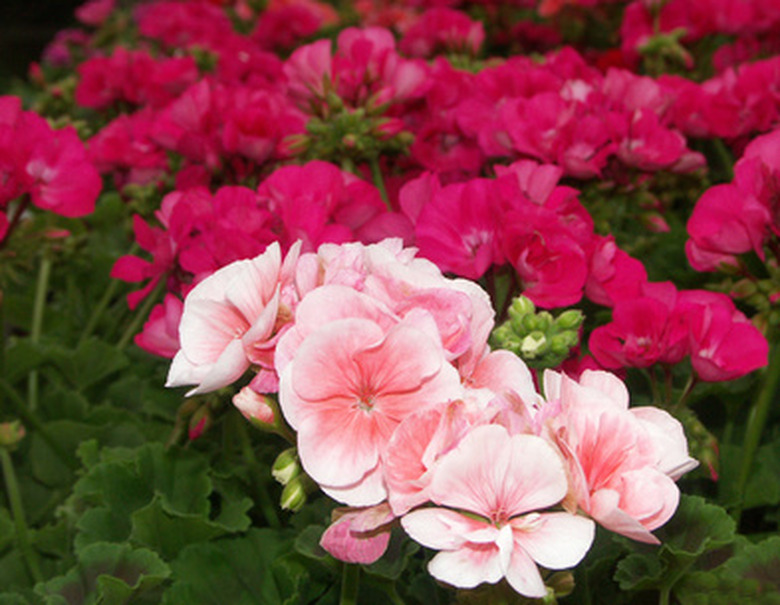Black Spots On Geraniums
Gardeners have a choice of more than 200 species of pelargoniums and geraniums to add nonstop blooms or scented, variegated leaves to their beds. The appearance of black spots on these plants is a blight that requires immediate attention. There are a number of possible causes, but the most recommended treatment is removal and destruction of all infected plant tissue.
Leaf Spots
Leaf spot diseases that damage geraniums can be caused by fungi or bacteria, says M.F. Huelsman of the Integrated Pest Management Center. They thrive in moist environments, so wet leaves caused by overwatering or humid climates are the most common way they infect plants. Organisms need a wet spot for an extended time, up to 24 hours, to allow the spores to germinate and the bacteria to penetrate natural openings in the leaf.
- Gardeners have a choice of more than 200 species of pelargoniums and geraniums to add nonstop blooms or scented, variegated leaves to their beds.
- They thrive in moist environments, so wet leaves caused by overwatering or humid climates are the most common way they infect plants.
Identification
Bacteria, fungus and pests can create similar or widely different kinds of spots. Some that begin as light green or yellow can turn brown (which can appear black) in the center or around the edges. Fungal leaf spots are typically brown or black and scattered across leaves. Dark spots on the underside of a leaf surrounded by concentric rings are the rust fungus. Spider mites feeding on leaves can cause a speckled surface. Stem rot shows as a dark spot at ground level or where a branch joins the stem. Any unnatural spot is a sign a plant needs help.
- Bacteria, fungus and pests can create similar or widely different kinds of spots.
- Spider mites feeding on leaves can cause a speckled surface.
Prevention
The best prevention comes with purchasing disease-free stock from growers who test for disease regularly, plant pathologists at North Dakota State University say. Consider planting species such as Martha and Lady Washington geraniums that are naturally resistant to diseases such as the common bacterial blight.
Defense
Don't give disease a chance to start. Keep leaves dry by watering at soil level in the mornings. This allows any splashed spots to dry in the sun. Inspect plants regularly. Many fungal and bacterial infections appear first as spots on the underside of leaves, so turn leaves over when checking geraniums. Watch for spots on all plants because other species can infect geraniums.
- The best prevention comes with purchasing disease-free stock from growers who test for disease regularly, plant pathologists at North Dakota State University say.
- Watch for spots on all plants because other species can infect geraniums.
Treatment
Bess Dicklow of the University of Massachusetts Plant Extension Diagnostic Lab says there are no sprays or drenches that will cure bacterial diseases such as the common bacterial blight. Diseases spread from infected foliage, soil or water, so the initial treatment is to remove and destroy all infected foliage and disinfect tools including hose nozzles. If the infection is widespread, entire plants should be destroyed to stop the disease. Keep geranium beds clean. In cold climates, remove all plant debris in the fall to prevent reinfection in the spring. Fungicides or pesticides can be effective against bugs and fungi.
